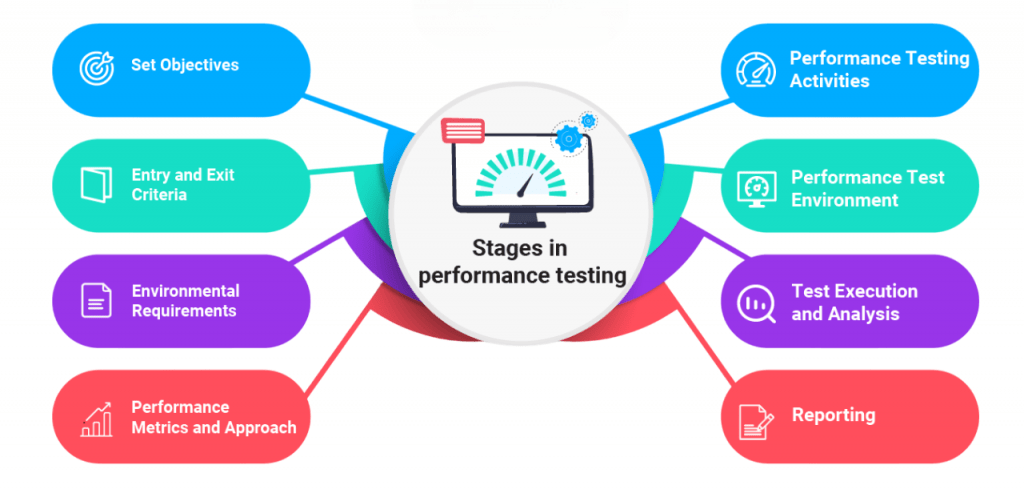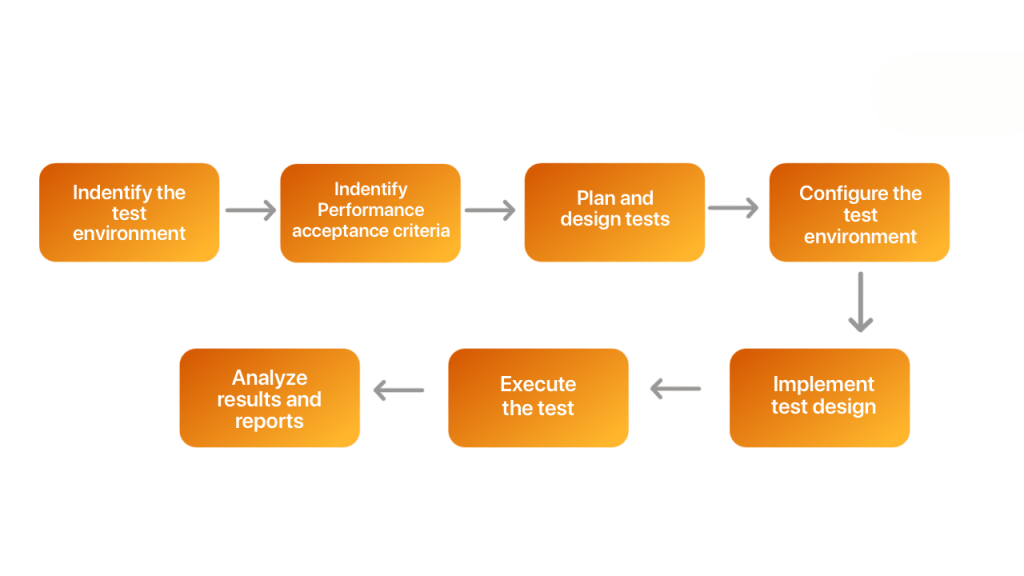
- Introduction to Performance Testing
- Definition of Performance Testing
- Why Performance Testing is Important
- Key Performance Testing Metrics
- Types of Performance Testing
- Performance Testing vs Functional Testing
- Common Performance Testing Tools
- How to Conduct Performance Testing Step-by-Step
- Real-World Scenarios Where Performance Testing is Critical
- Conclusion
Introduction to Performance Testing
As digital systems continue to scale in complexity, handling thousands or even millions of users simultaneously, making sure that for optimal application performance testing is mandatory, it’s essential. Poor performance results in frustrated users, lost revenue, and reputational damage. This is where Performance Testing comes in, acting as a shield against scalability and speed issues before the product hits the real world. Whether it’s a mobile app, website, banking system, or SaaS platform, To guarantee responsiveness, all applications must go through application performance testing, stability and scalability under a given workload. This blog will dive deep into what performance testing is, its types, metrics, tools, and why it is crucial in modern software development.
Are You Interested in Learning More About Software Testing? Sign Up For Our Software Testing Certification Training Today!
Definition of Performance Testing
- User Satisfaction: Users expect quick load times and seamless experiences. Performance testing ensures smooth navigation and interaction.
- Avoiding Bottlenecks: Identifies performance constraints that could slow down or crash the system.
- Scalability Verification: Confirms whether the system can scale to accommodate future growth.
- Reliability Assurance: Determines if the system maintains integrity under heavy load for extended periods.
- Compliance and SLAs: Ensures adherence to service-level agreements and industry standards.
- Optimized Resource Usage: Reveals areas of inefficient memory, CPU, or network usage.
- Response Time: The time taken by the system to respond to a request.
- Throughput: The number of transactions handled per second or minute.
- Load Time: The time taken for a page or screen to fully load.
- Peak Load: The maximum number of users the system can support.
- Concurrency: Number of users performing actions simultaneously.
- CPU and Memory Usage: Helps identify resource-intensive processes.
- Error Rate: The percentage of failed requests under load.
- Apache JMeter: Open-source and widely used. Supports load, stress, and spike testing. Works for web applications, APIs, and more.
- LoadRunner (Micro Focus): Enterprise-grade tool offering comprehensive performance testing features. Suitable for large-scale applications.
- Gatling: Developer-friendly and based on Scala. Offers real-time reporting and CI/CD integration.
- NeoLoad: Focuses on cloud, API, and mobile performance testing. Easy-to-use UI and enterprise support.
- BlazeMeter: Cloud-based platform built on JMeter. Enables scalable testing across global locations.
- E-Commerce: Black Friday sales and sudden traffic spikes can overwhelm untested systems. Performance testing ensures shopping carts, payment gateways, and search remain responsive.
- Banking and Finance: Applications must handle thousands of secure transactions per minute. Testing prevents outages and helps meet compliance and regulatory standards.
- Healthcare: Systems manage sensitive patient data and large concurrent accesses. Performance testing ensures stability during emergencies or peak usage.
- Government Portals: Tax portals, voting systems, and public service websites often see seasonal traffic spikes. Proper testing avoids crashes and downtime during critical periods.
- Online Education: Exam platforms and LMS tools encounter simultaneous logins and submissions. Testing guarantees uninterrupted learning and prevents data loss.
Performance Testing is a non-functional testing technique used to determine how a system performs in terms of responsiveness, stability and scalability under a particular workload. Rather than checking if a function produces the correct output (which is done in functional testing), performance testing answers questions like: When looking at how well an application works, it’s really important to check how fast it responds. Quick response times can make a big difference in how users feel about their experience. It’s also essential to see how well the system can handle a lot of users at once. We want to make sure it can support many people using it at the same time without slowing down. Plus, we should think about how stable the system is when it’s under constant use. We need to know if it can keep running smoothly without crashing or having long breaks in service. It simulates real-world scenarios to evaluate speed, load capacity, and system behavior under normal and extreme conditions, ensuring the software performs reliably in production.
Why Performance Testing is Important
Performance issues in production can be expensive to fix and damaging to brand reputation. Some critical reasons to conduct performance testing include:
In competitive markets, speed and uptime are just as important as features, making performance testing a non-negotiable part of the testing lifecycle.
To Explore Software Testing in Depth, Check Out Our Comprehensive Software Testing Training Course To Gain Insights From Our Experts!
Key Performance Testing Metrics
Effective performance testing relies on specific quantitative metrics to evaluate system behavior. Some of the most critical metrics include:

These metrics help testers, developers, and stakeholders evaluate whether the system meets performance expectations under various scenarios.
Types of Performance Testing
Performance testing is not a single method but a collection of test types, each with a specific goal: Load testing is a critical process that assesses a system’s behavior under expected user loads, confirming that there is no performance deterioration when handling average traffic in the application performance testing. In contrast, stress testing pushes the system beyond its normal capacity to identify breaking points, evaluating how it manages extreme conditions and recovers from failures. Similarly, spike testing examines the system’s reaction to sudden surges in user traffic, simulating scenarios such as flash sales, viral content, or breaking news events. Endurance, or soak testing, takes this a step further by examining the system’s performance over an extended period, checking for memory leaks and long-term stability issues. Finally, scalability testing determines the system’s ability to scale up or down in response to varying loads, validating its performance across different hardware configurations or cloud environments. Together, types of performance testing techniques offer a thorough grasp of a system’s robustness and effectiveness in a range of scenarios. Each type focuses on a different aspect of system performance and is crucial in delivering a robust user experience.
Performance Testing vs Functional Testing
Understanding the distinction between performance testing and functional testing helps teams allocate testing resources appropriately.
| Aspect | Performance Testing | Functional Testing |
|---|---|---|
| Purpose | Evaluate system speed, stability and scalability | Validate that the application behaves as expected |
| Focus | Non-functional requirements | Functional requirements |
| Input | High user loads, long durations | Test data, input values |
| Metrics | Response time, throughput, load capacity | Pass/fail criteria based on output correctness |
| Tools | JMeter, LoadRunner, Gatling | Selenium, QTP, Postman |
Both are essential but serve very different objectives within the SDLC.
Common Performance Testing Tools
There are numerous tools available to conduct various types of performance testing. Several well-known ones are:
These tools provide features such as scripting, reporting, CI/CD integration, and distributed testing to support varied business needs.
Want to Pursue a Software Testing Master’s Degree? Enroll For Software Testing Master Program Course Today!
How to Conduct Performance Testing Step-by-Step
Effective performance testing requires a systematic approach. Here’s a step-by-step process: Let’s break down the performance testing process into more relatable terms. It all starts with gathering requirements. This is where we really dive into understanding what the business needs, any service level agreements (SLAs) in place, and how users are likely to interact with the system. Getting this right sets the stage for defining what good performance looks like. Next up is setting up the test environment. It’s super important that this setup mirrors the real production environment as closely as possible. We want to make sure that the hardware, network, and system configurations are just like what they are in the live systems. Once the environment is ready, we need to pick the right performance testing tool. This choice depends on a few factors, like our budget, The kind of application performance testing that we are working on, and the technical skills we have on hand. After we’ve settled on a tool, we move into designing our test plan. This is where we figure out the specific scenarios we want to test think things like logging in, searching for items, and checking out. We also need to define how many users we want to simulate, how long the tests will run, and what kind of test data we’ll use.

When it’s time to execute and monitor the tests, we run them under different load conditions while keeping an eye on system metrics in real time. This helps us see how the system performs under pressure. After testing wraps up, we analyze the results to pinpoint any bottlenecks or failures. This leads to creating a detailed report that includes actionable recommendations for improvement. Finally, we enter the optimization and retesting phase. This involves working closely with developers to tackle any issues we found, and then running the tests again to confirm that the fixes have made a difference.
Real-World Scenarios Where Performance Testing is Critical
Performance testing is crucial across various industries and use cases:
In all these examples, performance testing protects business continuity and enhances user satisfaction.

